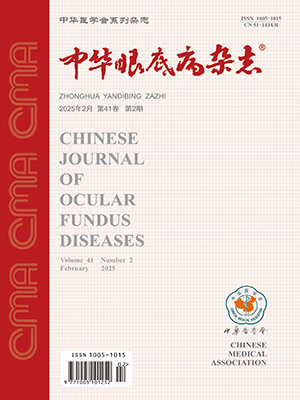| 1. |
Lejoyeux R, Benillouche J, Ong J, et al. Choriocapillaris: fundamentals and advancements[J/OL]. Prog Retin Eye Res, 2022, 87: 100997[2021-07-19]. https://pubmed.ncbi.nlm.nih.gov/34293477/. DOI: 10.1016/j.preteyeres.2021.100997.
|
| 2. |
Borooah S, Sim PY, Phatak S, et al. Pachychoroid spectrum disease[J/OL]. Acta Ophthalmol, 2021, 99(6): e806-e822[2020-11-30]. https://pubmed.ncbi.nlm.nih.gov/33258304/. DOI: 10.1111/aos.14683.
|
| 3. |
惠延年. 盘周厚脉络膜综合征: 厚脉络膜疾病谱的新病种[J]. 国际眼科杂志, 2023, 23(1): 1-3. DOI: 10.3980/j.issn.1672-5123.2023.1.01.Hui YN. Peripapillary pachychoroid syndrome: a novel entity of pachychoroid disease spectrum[J]. Int Eye Sci, 2023, 23(1): 1-3. DOI: 10.3980/j.issn.1672-5123.2023.1.01.
|
| 4. |
Zhang X, Sivaprasad S. Drusen and pachydrusen: the definition, pathogenesis, and clinical significance[J]. Eye (Lond), 2021, 35(1): 121-133. DOI: 10.1038/s41433-020-01265-4.
|
| 5. |
Fukuda Y, Sakurada Y, Yoneyama S, et al. Clinical and genetic characteristics of pachydrusen in patients with exudative age-related macular degeneration[J/OL]. Sci Rep, 2019, 9(1): 11906[2019-08-15]. https://pubmed.ncbi.nlm.nih.gov/31417165/. DOI: 10.1038/s41598-019-48494-6.
|
| 6. |
Azar G, Wolff B, Mauget-Faÿsse M, et al. Pachychoroid neovasculopathy: aspect on optical coherence tomography angiography[J]. Acta Ophthalmol, 2017, 95(4): 421-427. DOI: 10.1111/aos.13221.
|
| 7. |
Spaide RF. Disease expression in nonexudative age-related macular degeneration varies with choroidal thickness[J]. Retina, 2018, 38(4): 708-716. DOI: 10.1097/IAE.0000000000001689.
|
| 8. |
Sheth J, Anantharaman G, Kumar N, et al. Pachydrusen: the epidemiology of pachydrusen and its relevance to progression of pachychoroid disease spectrum[J]. Eye (Lond), 2020, 34(9): 1501-1503. DOI: 10.1038/s41433-020-0886-0.
|
| 9. |
Saurabh K, Roy R. Commentary: pachydrusen: a tell-tale sign of pachychoroid phenotype[J]. Indian J Ophthalmol, 2020, 68(1): 123. DOI: 10.4103/ijo.IJO_1534_19.
|
| 10. |
Kim YH, Chung YR, Kim C, et al. The association of pachydrusen characteristics with choroidal thickness and patient's age in polypoidal choroidal vasculopathy versus central serous chorioretinopathy[J/OL]. Int J Mol Sci, 2022, 23(15): 8353[2022-07-28]. https://pubmed.ncbi.nlm.nih.gov/35955481/. DOI: 10.3390/ijms23158353.
|
| 11. |
Baek J, Lee JH, Chung BJ, et al. Choroidal morphology under pachydrusen[J]. Clin Exp Ophthalmol, 2019, 47(4): 498-504. DOI: 10.1111/ceo.13438.
|
| 12. |
Matsumoto H, Mukai R, Morimoto M, et al. Clinical characteristics of pachydrusen in central serous chorioretinopathy[J]. Graefe's Arch Clin Exp Ophthalmol, 2019, 257(6): 1127-1132. DOI: 10.1007/s00417-019-04284-4.
|
| 13. |
Kaye R, Chandra S, Sheth J, et al. Central serous chorioretinopathy: an update on risk factors, pathophysiology and imaging modalities[J/OL]. Prog Retin Eye Res, 2020, 79: 100865[2020-05-11]. https://pubmed.ncbi.nlm.nih.gov/32407978/. DOI: 10.1016/j.preteyeres.2020.100865.
|
| 14. |
陈青山, 陈璐, 赵霞, 等. 微脉冲激光阈值下治疗黄斑软性玻璃膜疣和玻璃膜疣性DPED的形态学改变[J]. 国际眼科杂志, 2020, 20(6): 934-939. DOI: 10.3980/j.issn.1672-5123.2020.6.02.Chen QS, Chen L, Zhao X, et al. Morphological changes in the treatment of macular soft glassy degeneration and glassy degeneration-associated DPED under the threshold of micro-pulse laser[J]. Int Eye Sci, 2020, 20(6): 934-939. DOI: 10.3980/j.issn.1672-5123.2020.6.02.
|
| 15. |
Lai TYY, Tang Z, Lai ACW, et al. Association of fundus autofluorescence abnormalities and pachydrusen in central serous chorioretinopathy and polypoidal choroidal vasculopathy[J/OL]. J Clin Med, 2022, 11(18): 5340[2022-09-11]. https://pubmed.ncbi.nlm.nih.gov/36142987/. DOI: 10.3390/jcm11185340.
|
| 16. |
Cheung CMG, Gan A, Yanagi Y, et al. Association between choroidal thickness and drusen subtypes in age-related macular degeneration[J]. Ophthalmol Retina, 2018, 2(12): 1196-1205. DOI: 10.1016/j.oret.2018.06.014.
|
| 17. |
Liu T, Lin W, Zhou S, et al. Optical coherence tomography angiography of flat irregular pigment epithelial detachments in central serous chorioretinopathy[J]. Br J Ophthalmol, 2021, 105(2): 233-238. DOI: 10.1136/bjophthalmol-2019-315318.
|
| 18. |
Su Y, Zhang X, Gan Y, et al. Characteristics and associated factors of flat irregular pigment epithelial detachment with choroidal neovascularization in chronic central serous chorioretinopathy[J/OL]. Front Med (Lausanne), 2021, 8: 687023[2021-09-06]. https://pubmed.ncbi.nlm.nih.gov/34552940/. DOI: 10.3389/fmed.2021.687023.
|
| 19. |
Kang HG, Han JY, Kim M, et al. Pachydrusen, choroidal vascular hyperpermeability, and punctate hyperfluorescent spots[J]. Graefe's Arch Clin Exp Ophthalmol, 2021, 259(8): 2391-2400. DOI: 10.1007/s00417-021-05180-6.
|
| 20. |
Daruich A, Matet A, Dirani A, et al. Central serous chorioretinopathy: recent findings and new physiopathology hypothesis[J]. Prog Retin Eye Res, 2015, 48: 82-118. DOI: 10.1016/j.preteyeres.2015.05.003.
|
| 21. |
Singh SR, Iovino C, Zur D, et al. Central serous chorioretinopathy imaging biomarkers[J]. Br J Ophthalmol, 2022, 106(4): 553-558. DOI: 10.1136/bjophthalmol-2020-317422.
|
| 22. |
Nam KT, Chung HW, Jang S, et al. Ganglion cell-inner plexiform layer thickness in eyes with nonexudative age-related macular degeneration of different drusen subtypes[J]. Retina, 2021, 41(8): 1686-1696. DOI: 10.1097/IAE.0000000000003100.
|




